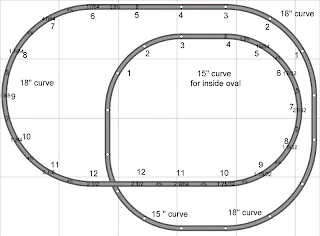Whatever size, shape, or design you decide on you will want a sturdy foundation. I have some articles on the planning stages of benchwork listed on the right-hand side of this blog that may help you answer some questions about your design.
Doing it right from the beginning will save a lot of future headaches.
There are a lot of good books on the subject of benchwork for model trains and my advice would be to get your hands on one. I have built benchwork from scratch and with out any advice, but I can’t advise it.
Benchwork, like most everything in model railroading, has no “right way” to build. The best method for you will depend upon the type, size, your room dimensions, portability desired, whether you want a free-standing table or a wall-mount.
Regardless of what layout you plan to place on it, benchwork needs a solid framework to support your model railroad empire correctly. Two types of framework are available - Butt-Joint and L-Girder.
Butt-Joint Construction
Butt-joint is quite popular and is similar to what you might find if you laid an interior wall flat and removed the Sheetrock. With this method, joists butt up against girders as shown in the simple diagram to the right. The joists and girders are secured together with screws inserted into the ends of adjoining pieces.
You can place a tabletop (such as plywood) or secured the roadbed directly on top of this framework. Either method works equally well.
Butt-Joint construction works well for small to medium-sized layouts that may need to be moved. Since this design results in right-angles it’s good for layouts that are rectangular or square.
Butt-joint constructions biggest drawback is that it requires precise cutting. Even a small error will make butting the members together very difficult. It’s also more difficult to create irregular shapes that are so popular in linear design. I’m not saying it can’t be done, it just takes more planning.
L-Girder Construction
L-girder, also known as “lattice framing”, is more popular and versatile. It’s easy to form layouts in the shape of T’s or I’s. Girder sections support the joists. The joists support the roadbed and/or tabletop. Be combining these two layers of construction a much wider degree of flexibility is allowed.
L-girder design is sturdier that butt-joint. The joints are stronger as the screws don’t go into the ends of the wood grain. Since joist sit on top of the girders it very simple to adjust several joist to make irregular shapes needed to accommodate rail yards and large scenic areas. The sides of the layout don’t have to be straight, allowing for the popular linear design.
Another advantage is it’s ease of construction. Cuts don’t require the exactness that butt-joint requires. L-girder is simple to revise later on. The biggest advantage is the ability to reposition any joist at any time during the construction phase. This will prove to more advantageous than you might think if you’re working on your first layout.
Is one better than the other? Well, that depends on your unique situation. You may even find a combination of the two works best for you.
I can’t possibly cover everything you need to know in this blog about benchwork for model trains. I highly suggest you check out some to the great books on benchwork. This is an area that is hard to correct after you have your tabletop attached, track laid, and then find your terrain won’t fit or needs to me modified.
A couple of books I own and used for references are:
Basic Model Railroad Benchwork: The Complete Photo Guide (Model Railroader)
How to Build Model Railroad Benchwork, Second Edition (Model Railroader)




